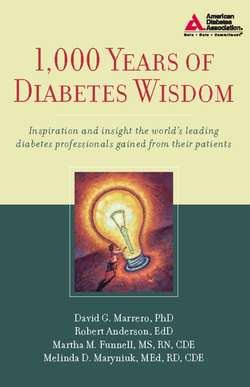Читать книгу 1,000 Years of Diabetes Wisdom - David G. Marrero - Страница 16
На сайте Литреса книга снята с продажи.
ОглавлениеCHAPTER 2
Listening and Asking Questions
The Value of Authenticity
by Lynn Arnold, dietitian, Dayton, OH
Long before I knew anything about diabetes, I learned about listening. Prompted by the pain of relating to loved ones with addictive behaviors, I attended my first 12-step meeting. I had no idea what to expect. I learned that this meeting began with a standard opening reading and introductions before breaking into groups of 8–12 people. Each small group gathered around a table for discussion, or so I thought.
Two or three people talked before I contributed some suggestions I thought might help their situation. Few words escaped my mouth before someone let me know that advice was not permitted. I was taken aback and immediately stopped talking.
Eventually I realized that these small groups were not for discussion, but offered the opportunity for one person at a time to say whatever they wanted to say without interruption. Sometimes the opportunity to speak proceeded in order around the table. Other times, order was random, but no one was ever permitted to speak a second time unless everyone had a chance to speak once, and each person could only tell their own story and not comment on someone else’s story. Some people would ramble while others were quite lucid. Some shared only a few words and others said nothing at all. For me, this was an entirely new way of relating to others.
I was surprised by how much I appreciated my chance to talk without interruption. It felt like it was a safe place to express my thoughts and feelings. No one was waiting for me to take a breath so they could jump in with their thoughts. I could actually finish expressing what was on my mind. I tend to elaborate more than is necessary to communicate a story. But being listened to communicated respect for what I felt was important. I also felt no pressure or temptation to sculpt my comments to impress, since no one was going to comment one way or the other. I found myself returning week after week, becoming more aware of my own thoughts as I worked to articulate them.
As an educator, I see enormous value in giving patients the opportunity to share their thoughts and feelings about living with diabetes. My job includes providing an environment where patients feel safe enough to speak the truth. My goal is to provide my patients with a safe place with no interruptions and no judgment. For me, this means listening attentively without expressing my opinion.. Maintaining a safe environment has meant looking for alternate (neutral) ways to communicate information and express recommendations.
Although choices have consequences, no one has to do anything. I try to present information as “current recommendations or facts as we know them today.” My patients decide for themselves how close they want to aim and how quickly they can make changes to accomplish it. My listening skills were born of my experience of others listening to me, a gift I try to pass on.
Focusing on the Individual Patient
by Robert Anderson, psychologist, Ann Arbor, MI
For many years, our empowerment approach focused on one-on-one teaching and counseling. A few years ago, we decided to develop an approach to group teaching. Marti Funnell, MS, RN, CDE, conducted the first pilot test of our new approach while I sat on the side observing the group. At the beginning of the class, Marti gave each patient a report containing their own A1C results, lipid profile, blood pressure, height, weight, and BMI. The report also contained the normal range as well as a list of six to eight behaviors that could either raise or lower each value. After handing an individualized report to each patient, she encouraged the group to spend a few minutes looking over their results.
After waiting a few minutes, Marti said, “Does anybody have any questions?” Just about every hand in the room went up, and an animated 90-minute question and answer session ensued. Marti spent the entire session addressing the questions and concerns of individual patients and, by the end, had provided a complete introduction to diabetes, hyperlipidemia, and hypertension. This patient-centered session was dynamic, relevant, and pragmatic. As I sat watching, the explanation for the patients’ enthusiastic participation hit me. I realized that patients don’t come to diabetes education programs because of an intellectual interest in diabetes, they come because they want help managing their diabetes.
I remember writing down the following sentence: Patients are not interested in diabetes; patients are interested in their diabetes. That insight provides the foundation for our approach to group teaching. We have completely eliminated lectures; all sessions are now based on the problems, concerns, and questions of the patients in the class. The curriculum for our group program is the lived experiences of our patients.
Answering Important Questions
by Luciana Bruno, dietitian, Sao Paulo, Brazil
It was late 1994 and I had just graduated—all do’s and don’ts and diabetic diets whirling on my mind—about to have my first patient! I thought, at last, a unique chance for me to help a diabetic patient out, and time to have a hands-on job. With a broad smile on my face, I welcomed in a middle-aged housewife, who had type 2 diabetes.
For about 40 minutes, I tried to explain to her what she needed to do and what she wasn’t supposed to do. At the very end of our appointment, when I thought we were done, I asked the woman if she had any doubts about our conversation. She then anxiously asked me, “Doctor Luciana, I was wondering if diabetes is contagious? You know, I take care of my five grandchildren while my daughters are at work. Tell me, please. Will I be able to keep doing this or should I quit doing it?”
